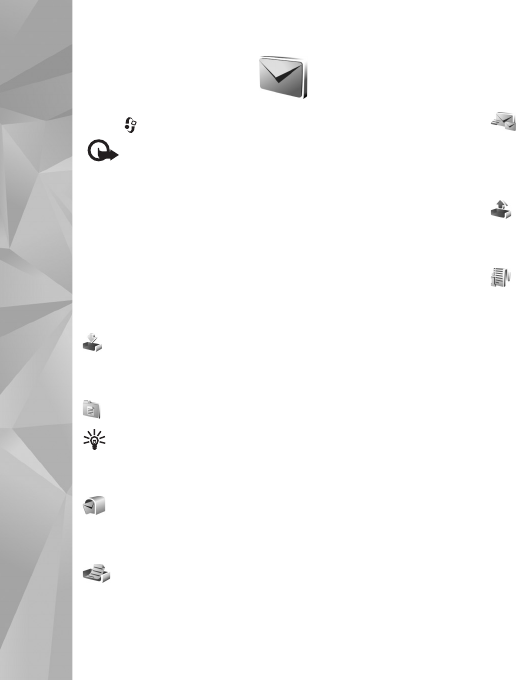
Messaging
34
Messaging
Press , and select Messaging (network service).
Important: Exercise caution when opening
messages. E-mail messages may contain malicious
software or otherwise be harmful to your device or PC.
Only devices that have compatible features can receive
and display multimedia messages. The appearance of a
message may vary depending on the receiving device.
To create a new message, select New message.
Messaging contains the following folders:
Inbox—Received messages, except e-mail and cell
broadcast messages, are stored here. E-mail messages are
stored in the Mailbox.
My folders—Organize your messages into folders.
Tip! To avoid rewriting messages that you send often,
use texts in the templates folder. You can also create
and save your own templates.
Mailbox—Connect to your remote mailbox to retrieve
your new e-mail messages or view your previously
retrieved e-mail messages offline. See ‘E-mail’, p. 41.
Drafts—Draft messages that have not been sent are
stored here.
Sent—The last messages that have been sent,
excluding messages sent using Bluetooth connectivity are
stored here. To change the number of messages to be
saved, see ‘Other settings’, p. 43.
Outbox—Messages waiting to be sent are temporarily
stored in the outbox, for example, when your device is
outside network coverage.
Reports—You can request the network to send you a
delivery report of the text messages and multimedia
messages you have sent (network service).
To enter and send service requests (also known as USSD
commands), such as activation commands for network
services, to your service provider, select Options > Service
command in the main view of Messaging.
Cell broadcast (network service) allows you to receive
messages on various topics, such as weather or traffic
conditions, from your service provider. For available topics
and relevant topic numbers, contact your service provider.
In the main view of Messaging, select Options > Cell
broadcast.
Cell broadcast messages cannot be received in UMTS
networks. A packet data connection may prevent cell
broadcast reception.
